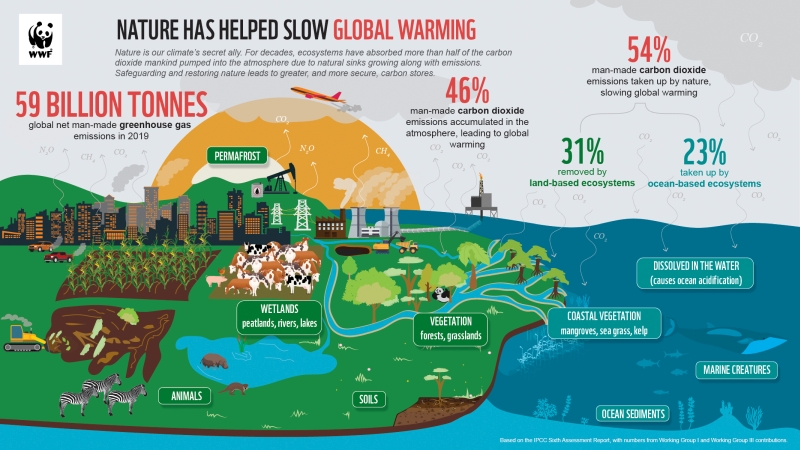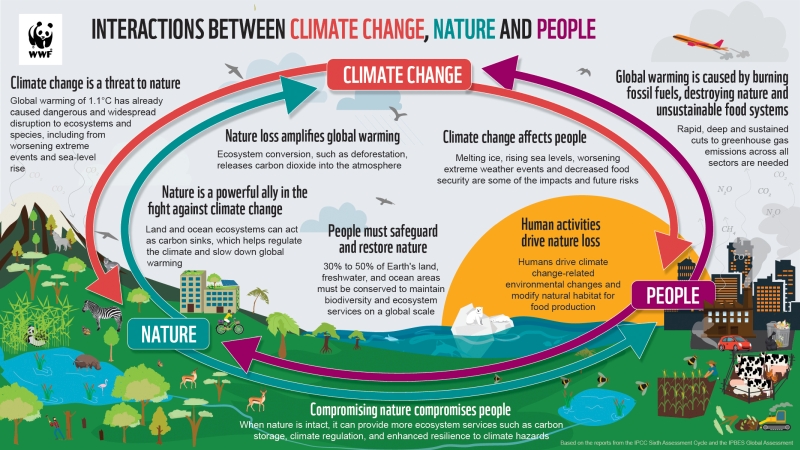- Nature has absorbed 54% of human-related carbon dioxide emissions over the past 10 years. This has slowed global warming.
- Global warming of 1.1°C is already causing dangerous and widespread disruption in nature, with ecosystems being pushed beyond their limits.
- We are losing nature as our ally. As polluting human activities escalate, nature’s capacity to absorb carbon and help us adapt and build resilience is weakening.
- Government at COP27 must recognise the important role nature can play in achieving the goals of the Paris Agreement.
“Nature is a climate ally, but natural systems are being pushed beyond their limits by the unrelenting pressure from climate change, pollution, over-exploitation and ecosystem conversion,” said WWF Deputy Global Lead for Climate and Energy, Dr Stephen Cornelius.
We will not halt climate change if we allow the crisis in nature to continue unabated. By the same token, if we are unable to limit warming to 1.5°C, climate change is likely to become the dominant cause of biodiversity loss in the coming decades. As the interlinkages between the climate system and nature on land, freshwater systems and in the oceans become ever clearer, so too does the urgent need to bring together our efforts to stop and reverse nature loss and decarbonise the global economy.
These interlinkages are highlighted throughout the work of the Intergovernmental Panel on Climate Change (IPCC), the UN body responsible for explaining the latest climate science to the world’s policymakers. Its Sixth Assessment Report makes clear both that climate change is negatively impacting nature, but also that healthy nature is an ally that helps prevent climate breakdown and make us more resilient to a warming planet.
“Our capacity to restore healthy ecosystems and a healthy planet is constrained by global warming,” said Professor Hans-Otto Pörtner, IPCC Co-Chair, Working Group II. “Benefiting from the many services ecosystems provide depends on successfully reducing emissions and keeping global warming to 1.5°C or below. The evidence is stronger than ever before that the world’s current climate and biodiversity crises depend on each other and can only be solved together.”
The science shows that Earth’s natural systems play a central role in regulating the climate – and in protecting us from the worst consequences of our actions. The world’s oceans, plants, animals and soils have absorbed 54% of man-made greenhouse gas emissions of the past 10 years. Critical ecosystems, such as wetlands, mangroves and coral reefs, help to shield us from the worsening hazards of extreme weather and sea-level rise.
 |
| © WWF |
But these natural systems are under threat and have their own limits. Rising temperatures and changing rainfall patterns are altering the ranges of animals and plants as they try to track their preferred climate, disrupting food webs and breeding patterns. Extreme weather events such as drought, wildfires and marine heatwaves, can destroy entire ecosystems and cause mass mortalities.
Beyond certain thresholds, some of the impacts become irreversible. The world’s tropical coral reefs face near-complete destruction even at 1.5°C of global warming. Once areas of rainforest become too degraded and fragmented, they can tip permanently into savannah. Sea-level rise will destroy many unique, biodiversity-rich low-lying coastal and river delta areas forever.
The risks threaten people as well as nature. Human societies, culture and our economy are fundamentally dependent upon nature – for food and water security, for air quality, for protection against disease, for energy, the list goes on. Many Indigenous Peoples and local communities depend directly on ecosystems for their survival.
Our new report - Climate’s Secret Ally: Uncovering the story of nature in the IPCC Sixth Assessment Report - draws upon the IPCC’s work to highlight the interlinked emergencies of human-induced climate change and biodiversity loss, threatening the well-being of current and future generations and to make the case for better integrating nature into our response to the climate crisis.
 |
| © WWF |
It is clear that, without harnessing the ability of nature to store carbon and help regulate the climate, it will be impossible to meet the goals of the Paris Agreement to limit global warming to 1.5°C above pre-industrial levels and avoid the worst risks of climate change. And without the protections healthy nature provides from climate hazards, more people will be at greater risk. Conserving 30 to 50% of land, freshwater and oceans areas could help safeguard nature, help protect the climate, and benefit people. Nature-based solutions, which protect and restore natural ecosystems, can both address climate change while supporting people and nature. Nature is a secret ally, but also untapped potential to help address the climate crisis.
But nature can’t do all the work alone. We must rapidly and equitably cut greenhouse gas emissions, with all sectors and all countries needing to contribute. We need to provide the financial resources to help the most vulnerable adapt.
At COP27, WWF urges leaders to recognise nature-based solutions within the outcome of COP27, embed them in climate action and create momentum ahead of the December COP15 biodiversity summit in Canada - humanity's unmissable opportunity to reset its broken relationship with nature.
By employing all of these actions we must change our current trajectory from around 2.5°C warming by the end of this century. There is no space for delays – overshooting 1.5°C poses terrible climate change risks on both people and nature.
We hope this report amplifies the important work of the IPCC by spotlighting the story of nature and climate change – including what it is doing for us already in the fight against climate change and how this is dangerously at risk. Nature can continue to help us in the fight against climate change, but only if we help it first.





